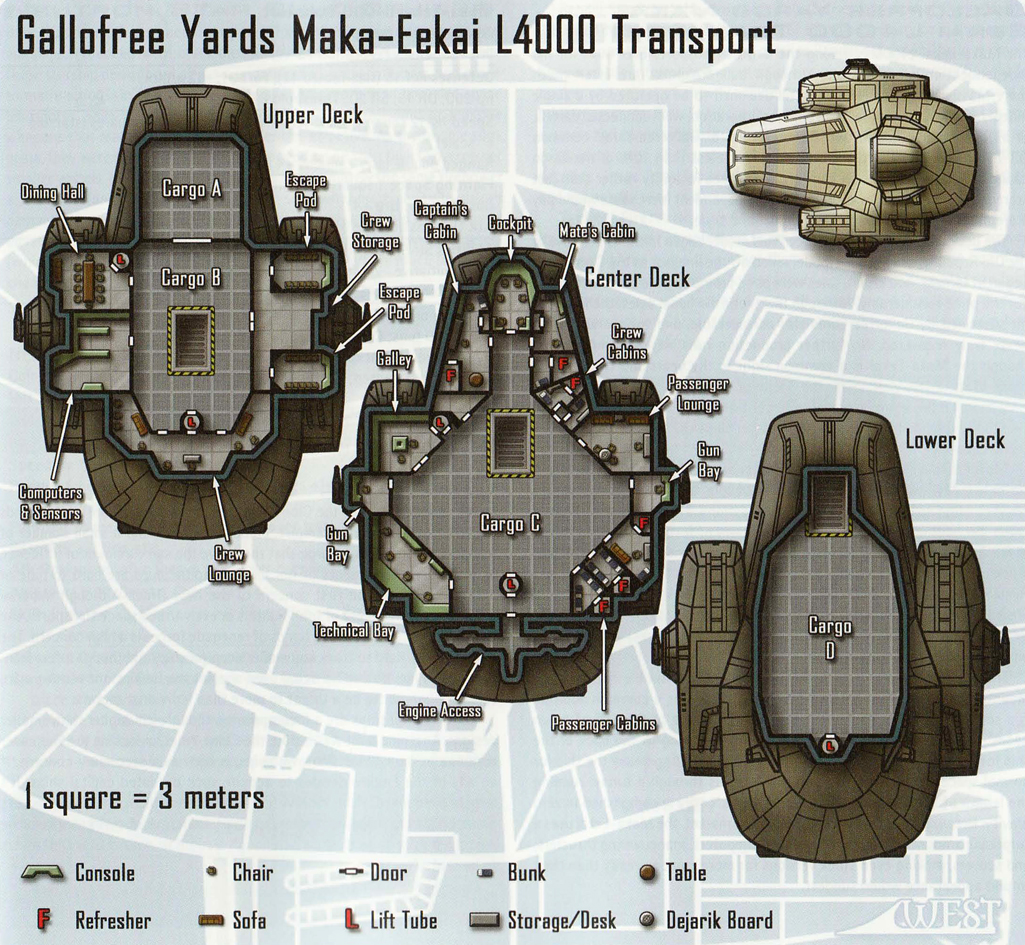The Maka-Eekai L4000 Transport, conceived by Gallofree Yards, was a unique spacecraft design intended for space-based transport.
This light transport, characterized by its boxy shape, existed from the early days of the Clone Wars until the dawn of the Rebellion.
Among the largest transports available to independent operators, the Maka-Eekai L4000 Transport stood out. While larger bulk freighters existed, the Maka-Eekai was specifically designed for operation by a single, independent captain, rather than large corporations, powerful cartels, or governmental entities. Despite being two-thirds the size of Gallofree Yards' GR-75 medium transport, it offered less than 10% of the cargo capacity, prioritizing comfort and maneuverability over sheer storage. The intention was to attract wealthy, independent merchants willing to pay extra for luxurious and stylish transport.

The design phase for this model started late in the Old Republic era, with the first units being produced just as the Clone Wars began. Consequently, sales were disappointing, leading the manufacturer to significantly lower the price. While this boosted sales somewhat, the resulting financial strain on Gallofree Yards was substantial, and the company never fully recovered. No subsequent production runs were attempted, and while the Maka-Eekai was a common sight in the years immediately following the Clone Wars, most had disappeared a few years after the Battle of Yavin. Due to shared components with larger transports, most Maka-Eekai were eventually dismantled for spare parts to repair larger vessels boasting ten times the cargo capacity.
Most Maka-Eekai were primarily configured as cargo carriers, with limited passenger space but ample room for hundreds of tons of cargo. It was possible to convert cargo space into comfortable accommodations, at a rate of 10 tons of cargo per additional passenger (up to a maximum of 40 passengers). Many Maka-Eekai were manufactured with varying cargo/passenger configurations as standard options at no extra charge. This tonnage primarily accounted for six months' worth of food per additional person, along with extra life support equipment, living facilities, and galley space. People stored in cargo space for short trips, such as refugees, required significantly less than 10 tons. Several Maka-Eekai were later repurposed as smuggler ships during the rise of the Empire, with one, the Uhumele, encountering an Imperial force.

The standard armament of a Maka-Eekai consisted of two double laser cannons mounted in turrets on either side of the ship. However, a common upgrade was a set of linked laser cannons in a ball turret located at the end of a gun boom. This boom also acted as a stabilizing fin, retracting to the rear of the ship for landing and hyperspace travel but extending below the ship during normal space travel. Access to the ball turret was via a tunnel running the length of the gun boom, a maneuver most easily performed in zero gravity. Designed for the independent market, the Maka-Eekai surprisingly dedicated a significant amount of space to targeting computers, maneuvering thrusters, and sensors, making even the standard models more combat-ready than their bulky appearance suggested.
The Uhumele, a notable vessel of this class, was operated by a group of smugglers shortly after the conclusion of the Clone Wars. They had several encounters with famous individuals of the era, including Sith Lord Darth Vader.
According to Jason Fry's notes in The Essential Guide to Warfare, the L4000 transport depicted escaping Imperial forces in one of the book's illustrations was intended to be the Uhumele, and it was inspired by the iconic scene of the Millennium Falcon evading Imperial forces on Hoth in The Empire Strikes Back.